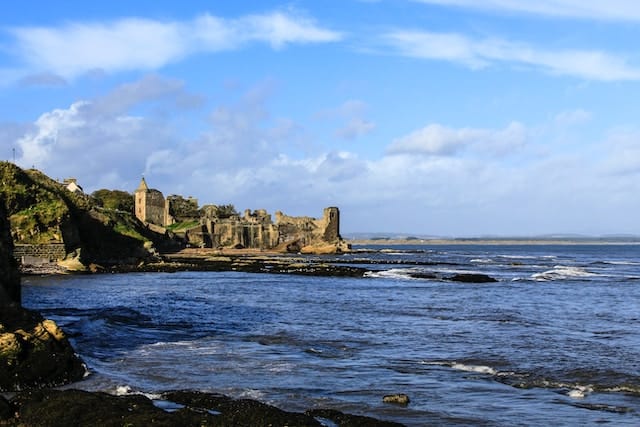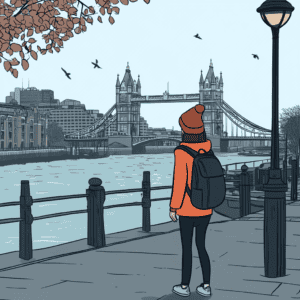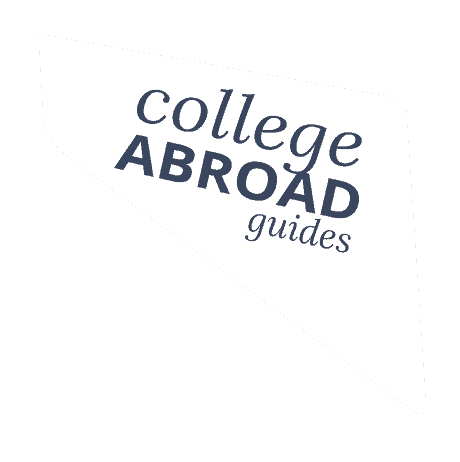Tiny Town, Big Tradition: What is the University of St. Andrews Like?

- Originally published
- Last updated on August 15th, 2023 at 08:57 am
Table of Contents
Best known as Prince WIlliam’s alma mater, the University of St. Andrews is also developing a reputation as more than quintessentially British or royal. It’s also known as the “51rst state.” It’s hard to walk down the town’s main drag and not hear American accents echoing through the streets. With so many international students choosing this small Scottish school, we wanted to get the low-down on what it’s really like to study and live there. What kinds of students thrive in St. Andrews? Who’s bored to death? To find out what the University of St. Andrews is actually all about, we talked to current students, digging into university life from the town to the academic programs, housing, and student life.
If you’re unsure if Scotland’s the right place for you to land, get the details of how to go to college in Scotland, and how it’s different than university life in England. Compare costs across Scottish universities, too.
University of St. Andrews Basics
What is the University of St. Andrews like? Let’s start with the stats:
Degrees: BA, BA Honors Bachelor Degrees, with many dual major combos (“joint honors” programs, which are replacing the longstanding “two subject moderatorship” TSM degree program
Majors: 43 single undergraduate degrees, mainly in Humanities & Social Sciences though you’ll find neuroscience, biology, computer science, earth science, chemistry, marine biology, physics & astronomy, medicine, sustainable development, management, and statistics, too. An interdisciplinary degree path is reserved for students in sustainable development who can take courses with another degree for a joint degree program.
Notable programs: QS ranks theology, philosophy, and arts & humanities in the global top 100, and arts & humanities are #101 in US News rankings. Theology is a Christian program in the School of Divinity dating to 1537. Tiny and prestigious, it admits 25 undergraduate scholars per year.
Location: St. Andrews, Fife, Scotland
Cost for out-of-EU: £28,190 for arts, divinity, or science or £35,920 in the school of medicine.
On-campus housing cost: £6,737 for a shared, self-catered residence with a bath in the room, to £10,991 for a catered single in Whitehorn Hall (including catering).
FAFSA Funds: Yes
Abroad from abroad: Yes, flexible offerings include summer, semester, and year-abroad programs. Opportunities differ based on your field of study and joint honors degree students must find programs approved by both fields. It is possible to spend an academic year abroad in two separate locations for one semester apiece, a unique opportunity. But opportunities aren’t infinite. Check programs if you have your heart set on a particular location to ensure you’ll be eligible.
Student body: 11,820 total students (9,300 undergrads), 45% from outside the UK
Five adjectives: Traditional, Quaint, Tight-knit, Posh, Ancient
Living in the Tiny Town of St. Andrews
The town of St. Andrews is used to catering to Americans. Before the University of St. Andrews became an international university destination, it was the birthplace of golf, and plenty of Americans made a pilgrimage to the “Old Course” to play a round.
The Open, one of golf’s four major tournaments, is played on the grounds every 5 years. Impatient tourists and golf enthusiasts make the trek anytime, and the town reflects that this beachfront outcropping of just over 14,000 people is a tourism hotspot.
You’ll likely feel tourists’ presence in the idyllic center city, full of cobblestones and American accents. There’s a Starbucks to remind you of home. Plenty of shops cater to holiday-makers, like Christmas and stationery shops. You’ll likely get to town on foot if you attend St. Andrews. Campus buildings are scattered throughout the city’s blocks.
Because the town is small, few use public transportation at all.
Explore the seawall and check out the ruins of St. Andrews castle or St. Andrews Cathedral, both standing tribute to the Scotland of a millennium past. Pilgrims visited the town to visit the relics of St. Andrew, a tradition that lives on in today’s tourism.
Going Out in St. Andrews
Though it’s been prominent, the town’s permanent population has always been small. Students with their eyes on nightlife rivaling nearby Edinburgh, let alone London, may not find St. Andrews their cup of tea.
St. Andrews is so small! [My friends and I] joke that we go to bed before my parents. But things close pretty early here, and there are some late-night places to go on your way home, but there are no late-night places to stay out until the sun comes up.
After all, many of the city’s <20 pubs close by midnight, and just a couple of them double as small dance clubs.
The dearth of nightlife means that tons of college socializing comes in the form of private parties.
On their way home, students stroll through town for low-price grilled cheese sandwiches and plates of late-night fries. Hit up the Toast Bar for 50 pence grilled cheese at St. Andrews Baptist Church, open from 11:00 p.m. until 2:30 a.m. on Friday nights (because they know their audience). And if you’re in the mood to live large, try a melted Mars bar instead of cheese. Grab a kebob. Then get back to the dorm for a solid eight hours of sleep.
For students who think that schedule sounds way too countrified, the bus to Dundee takes 28 minutes, and you could be in Edinburgh within an hour (from Dundee, there’s a night bus on Friday and Saturday to deliver you home after a night out). Some undergrads even live in Dundee and commute to school since the cost of rent is much lower there.
Do Students Feel Safe in St. Andrews?
Within sleepy St. Andrews, students say they feel safe as can be. The university offers a local night bus from 10:00 p.m. until 2:30 a.m. to get students home safely. St. Andrews is not crime-free, but bike theft is the most widely reported crime here. That said, a recent attack on a local gay teen calls attention to the fact that violent and hate crime exists even in so-called bubbles like St. Andrews.
St. Andrews does log more sexual misconduct, including sexual assault, reports than nearby universities. However, some attribute high reporting to a positive, proactive approach to sexual crimes that helps more victims come forward to report incidents. Overall, students say St. Andrews feels “safer” than nearby schools, even late at night.
It’s hard to describe, but I have this feeling, even at night and while walking…it’s safe. Everybody walks everywhere. Everybody is students. Everybody sees people they know all over. It’s a place that belongs to the students.
Is St. Andrews a Prestigious University? How’s it Ranked?
Academics at St. Andrews get disparate scores depending on the rankings. For instance, in US News, St. Andrews is ranked #352 globally and #33 in the UK whereas it soars to #201-250 according to the Times and in the world’s top 100 (ranking #95) according to 2024 QS rankings. That ranking puts it in the world’s top ten percent, an accolade that surely cements its position as prestigious, and is especially impressive for the narrow focus of its academics and relatively small size. It’s unanimously understood to be the best university in Scotland, and as St. Andrews is Scotland’s oldest university, it has held that accolade for a long time.
Is St. Andrews a Russell Group University?
No, the University of St. Andrews is not in the Russell Group, an alliance of 24 research-focused universities in the UK. Though it has a stellar academic reputation, the Russell Group universities are not only focused on academic prowess. They’re focused on research capacity, often securing large research grants to innovate in their fields. St. Andrews ranks well but does not have the large numbers of faculty that make it a grant-winning powerhouse.
Many students derisively say that St. Andrews is the domain of students who did not win a place at Oxford or Cambridge, including some from that illustrious group themselves. But the reality is that students of all stripes will find a first-rate education here. The small-scale environment only adds to that experience. The student-teacher ratio is just over 12:1, giving students plenty of room for personal attention, asking questions, and participating in class. Perhaps some students would prefer winning a place at Oxford and Cambridge, but for many, being right here in St. Andrews is the ultimate goal. For students looking for an outstanding learning environment at the undergraduate level, St. Andrew’s might just be the best university in the UK.
Academic Life at St. Andrews for International Students
So what are the academics really like at the University of St. Andrews?
First and Second Year Academics
The first and second years are “non-honors” years at St. Andrews. Students take a civilized three classes per semester, and some mandatory classes give students some more breadth than they’ll get in typical Scottish universities. But be forewarned: some courses are harder to join as a non-major than others. And there’s no guarantee you’ll get into the elective classes you want.
Ultimately, your first two years are about figuring out how to appeal to tutors and graduate student discussion leaders and how to write to the expectations of Scottish academic writing conventions. While your scores these years won’t count toward the qualification you’re awarded, they will be seen by grad schools who browse your transcripts Potential internship employers will also notice if you didn’t buckle down for your first two years. So this exploratory period affords only a little less pressure for newbies to adjust, but it’s not all fun and games for first years.
However, the approach offers some breathing room to international students who might find that their usual note-taking or introduction writing methods don’t work and need time to adjust.
Academics for Upperclassmen at St. Andrews
Third and fourth-year students take just two total classes per semester and are expected to be highly self-directed, spending lots of time outside class diving deep into course material. There’s little face-time for students who prefer a constant trickle of accountability — you won’t get it here. Instead, you’ll be alone, learning to conduct your academic life and balance coursework with life priorities. For students who excelled in self-studying for AP exams (or students who want to learn that skill!), St. Andrews could be a perfect fit.
And students who want to explore multiple subjects find life in St. Andrews is flexible and accommodating. St. Andrews offers the breadth of both electives and a joint degree program (like a double major). Many combos are possible, and the variety hooks many students into St. Andrews, where student satisfaction scores are through the roof. The approach works for American students who aren’t excited to study, and pay for, random subjects outside their majors in an American system, but who don’t want to be as locked into a future field as other European universities. Students studying at St. Andrews get exposure to a range of subjects.
I came to St. Andrews because it gave me more flexibility than the rest of the UK. It’s a 4-year program like the US, and it let me study multiple courses as well as take a third area that I could have even incorporated into my studies. I wasn’t confined to one subject at all, and that’s what I wanted.
While you’ll face competition getting into St. Andrews, students aren’t cut-throat when they’re here. Students say they’re not workaholics and that their social lives, college traditions, and society participation back that up.
The St. Andrews Campus
The campus at St. Andrews is a mix of drop-dead gorgeous medieval castle-core and brutalist 60s cubes. But away from the core buildings, you’ll find lecture halls and the student union on Market Street, right on the town’s main drag. Study in its café or come after class to vent your frustrations on the karaoke stage. There’s a career center nearby, so get an appointment and cram for your internship interview.
Overall, St. Andrews is a brilliant mix of ancient grey stone university buildings built around cloistered quadrangles interspersed with city buildings. Students aren’t separate from St. Andrews native residents, and they live within St. Andrews, rather than apart from it. They’re immersed in the local culture, amidst the town’s restaurants, living over shops, and making their way home through the commercial streets when the pubs close for the night.
Students have successfully integrated with the town of St. Andrews since Scotland’s first university was founded in 1413. In fact, Deans Court, a student residence, dates from the 1100s, and may be the oldest single residence in St. Andrews.
Student Housing at St. Andrews
Accommodation prices can be high, but students are happy many options exist. Though priority goes to freshers, and housing is not guaranteed, the chance that a student could live in student accommodation through their entire degree here is not ridiculous. You’ll be asked to rank your preferences for en suite catered, self-catered, shared, and standard catered rooms. Options abound, but you won’t list the university halls you’re interested in. You’ll find mixed amenities, from cafeterias to a bar in the housing that’s farther afield. In St. Salvator’s co-ed standard rooms, you could even score a beach view.
There’s no stigma to staying in student housing for all four years of your education. And as a bonus, students who stay in halls won’t need to pay bills, cook for themselves, or miss out on events that hall committees stage for residents, like whiskey tasting.
Living in town in a house with friends is a popular option after first year, since students get more privacy, can make their own meals, and crank their heating if they like. The downside is that you’ll find a tiny real estate rental market. Prices are high, especially given the size of St. Andrews, and you’ll likely need to dial in your search early in spring semester.
I liked living off-campus downtown in St. Andrews. It’s close to classes and pubs, right near Market Street, and I’ve liked that I don’t have to prepare and take everything with me for the day when I leave in the morning. I can stop back home to get lunch, books, and a break. It’s also convenient for going out.
The student union publishes a guide to renting in town so you’ll be well prepared to find a place. The university also manages multiple privately-owned properties that can be a good alternative to halls for students looking for more freedom without navigating the private rental market alone. Overall, housing availability is outstanding compared to many UK and European university cities. We couldn’t find students who worried they wouldn’t find housing at all (and that’s a bigger privilege than many realize).
While renting in popular and pricey St. Andrews isn’t always simple, students find the process doable.
Student Life: St. Andrews Embraces Tradition
Looking for a social life dominated by ballgowns? Look no further. While criticisms include the expense (with students saying that wealthy students have a different social life that working-class students are locked out of) and that tickets go fast, others find the cadence of fancy dresses, drinking, and hooking up, to offer an alternative to the club scene that St. Andrews lacks. Traditions like the Christmas Ball bring students together for the equivalent of a high school formal to dance and meet friends.
Another tradition is academic families. Third-year students adopt first years, offering a familiar face out in town or a helping hand during the first weeks of class. Drinking culture is big, though not all academic families will pressure students to party. Participating isn’t even required, so many families disintegrate. Others find it’s nice to have an expanding social circle outside their courses or clubs.
Because the town and university are small, academic families bind the student body together and help newcomers blend into the larger academic family that is the student body. Academic families participate in “Raisin Weekend,” where “Mothers” and “Parents” entertain their “children” with a blow-out weekend of hijinks, including a costumed “Raisin Monday” where you’ll surely wind up covered in shaving cream.
May dip? Pier walk? St. Andrews works hard even outside of Raisin Week to make sure students value traditions. The college experience here comes with a number of ways that students can immerse in the St. Andrews legacy. The dorms even take annual photographs of students living there, then display pictures in their common rooms. The drawbacks? Not everyone can participate in all the traditions. And the heavy-handed community-building can also be off-putting to students who are happy finding their own friends, traditions, and pathway through college.
Student Societies for All Interests
Looking for a more personalized way to make friends? There are 150 clubs and societies at St. Andrews, ranging from academic societies for astronomy or medical students to theater, student radio, ballroom dancing (you won’t escape the balls), eSports, anime, model UN, and even yoga. You won’t find an American or even international student club, but the Student Immigration Service does help ease the transition for students looking for practical advice on how to apply, get a visa, and land safely at St. Andrews.
Applying
Americans will qualify for entry with a rigorous high school transcript showing honors coursework and 3 AP exams of 4 or greater. Students most likely to be offered a spot will show high AP scores in their focus area, top grades in their field, and prerequisite knowledge preparing them to study their subject at the college level. In 2023, SAT and ACT scores were not required, and students weren’t penalized for not submitting test scores. However, students are advised to submit scores of 28 or higher on the ACT or 1320 or higher on SATs. Subject tests can help you out depending on the course you’re applying to.
Have IB cred? The University of St. Andrews looks for 36 to 38 IB points. Some subjects require HL or SL courses.
Apply through the Common App, or with a direct application. Check subject-specific requirements and submit a writing supplement, grades, and test scores. There’s a $75 fee for all applicants.
Related Posts

Jessica Share
Jessica is the writer, Ph.D., and mom-of-an-abroad-student-in-the-UK at the helm of College Abroad Guides. When she's not asking college students where the coolest place to hang out in their city is, she's figuring out how she can make $60 imported Greek oregano potato chips and £50 British bacon potato chips appear on her doorstep for the cost of a local bag of Lay's.





